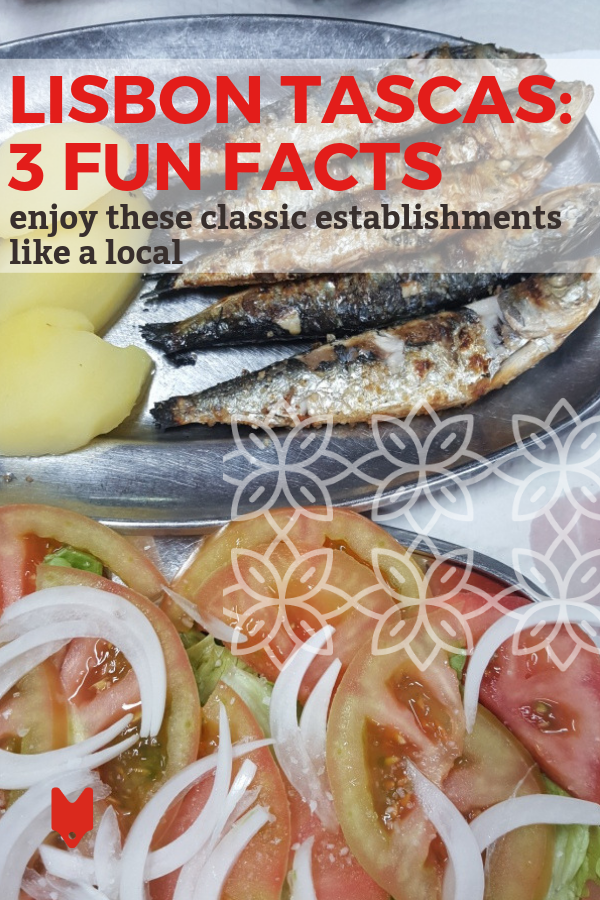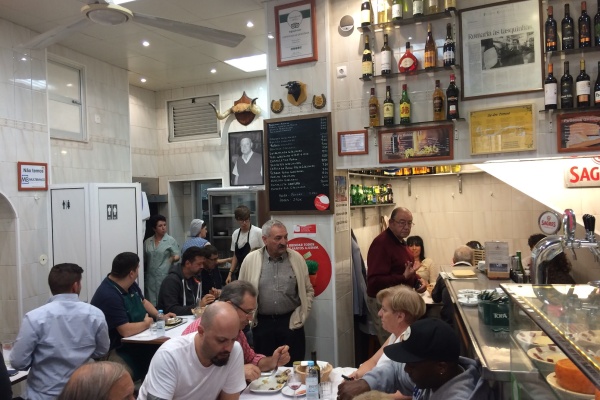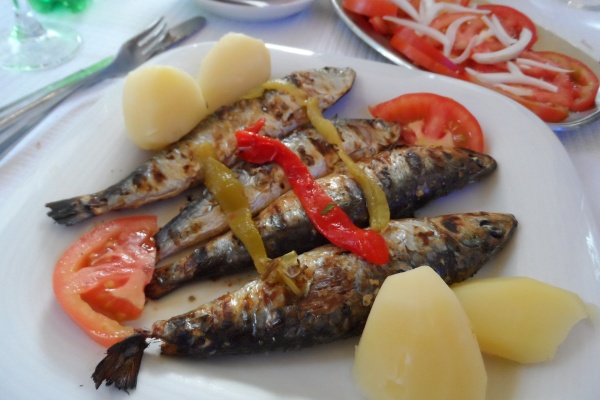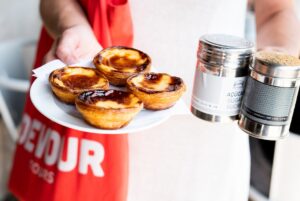Last Updated on December 5, 2025 by Emma Fajcz | Published: December 6, 2018
When in Lisbon, there’s no better place than a tasca to have lunch while feeling the city’s beating pulse.
Lisbon has changed and so have tascas since they opened in the late 19th century. But for someone visiting the city for the first time, these family-owned, tavern-like eateries look frozen in time. And overwhelming.
The service is whirlwind fast but extremely welcoming. The food portions are huge but affordable. There’s a worried, motherly voice that shouts from the kitchen if you didn’t finish your meal: “Was it not good? Would you prefer something else?”
No one should eat without enjoying their meal and no one at a tasca pressures you to give up your table. If a customer, regular or not, is in a hurry and the restaurant is full, the waiter will kindly but firmly ask you to scoot over and share the table. If there’s room for one more, there’s room for one more.

Photo Credit: vladimix, Text Overlay: Devour Lisbon Food Tours
The Origin of Tascas
Industrialization hit Lisbon in the second half of the 19th century and the city grew to accommodate the newcomers in new neighborhoods and apartment buildings. The growth was fast and the difference between old and new is evident. Stroll through the Graça neighborhood and you’ll see the vilas from those days: buildings built by factory owners to accommodate the new workers and their families.
These newcomers, most of them former farmers from smaller villages in Portugal, came to Lisbon not to live but to make money. They had no social ties to the local community and they didn’t feel that emotional connection with the city that would have made them feel like locals.
Tascas, at the time mostly owned by Galician immigrants, sold cheap wine, some petiscos, and coal. They were half-tavern, half-social places where tired and often underpaid factory workers went for a drink. For many, this was the only connection to an idea of a home.
Migrants from other regions in Portugal followed suit and later opened their own tascas. As the number of factories increased, tascas moved closer to them, focusing more on affordable food than wine, and doubling as a cafeteria for the workers. Because of their specialties like petiscos and the late closing hours, tascas then became the favorite hangout place for bohemians, artists, journalists and writers.

Tascas in Lisbon Now: A Beacon of the Local Cultural Identity
The tascas in Lisbon have changed over time, adjusting to current quality standards, like any other restaurant has. But they’re still the best place in town to eat traditional Portuguese food, and they still keep the same essence of when they started.
To keep up with the times, some may have added a second language to their menus (usually English) or began accepting credit card payments. But they haven’t changed the menu to cater to foreign palates. A bica is still a bica and still costs an average of €0.70 or less, and older waiters still find it easier to calculate your bill on the paper tablecloth than with a calculator. They never make a mistake and they’ll never overcharge a client.
Tascas never were—and still aren’t—just about the food. Workers still choose them for affordable lunches but also for that sense of seeing a familiar face. That connection from two centuries ago is still there. Some regular clients go to their favorite tasca for lunch every day, some only go when the daily special is their favorite dish.
Amid the modernization Lisbon inevitably went, and will go through, tascas have managed to remain true to their essence.

Tips to Spot a Traditional Tasca
A traditional tasca doesn’t change one ounce of its character to try and please everyone.
The daily specials are scribbled on a blackboard or a paper tablecloth taped to the window (so that the potential customers passing by can choose to enter or not). They don’t take reservations but the service is quick, so you don’t have to wait long for a table. It’s harder to find a tasca that also opens for dinner, except in areas like the Bairro Alto neighborhood where nighttime is the best time for business.
Over the years, the meanings of tasca and taberna have overlapped and these days they’re practically one and the same. However, since most tabernas still focus more on serving alcohol than food, you might find more regular clients drinking at the counter than eating at the tables.
Finally—and this is the golden rule—displaying the words “traditional” and “typical” all over the place doesn’t make a tasca traditional nor typical. Nor does it corroborate the place’s quality. To eat like a local in Lisbon and avoid getting lured into a tourist trap, follow locals—not signs.

If a tasca sounds like your kind of place, you’re our kind of person. Join our Tastes & Traditions of Lisbon Food Tour to get to know more of the ins and outs of Lisbon’s food culture, bite by bite.








